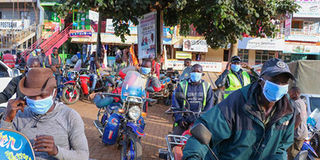How to handle your face mask correctly

Boda-boda operators in Chuka town, Tharaka-Nithi County, use face masks to shield themselves from coronavirus. PHOTO | FILE | NATION MEDIA GROUP
What you need to know:
- The experts warned against touching the front of the masks, especially with evidence showing that the virus could be airborne.
- Dr Nyaim warned that while the public could benefit from wearing masks, improper use could cancel all the benefits that come with the protective gear.
While Kenyans seem to have heeded the call by the Ministry of Health to wear face masks, experts have raised concern that some people are wearing them in a way that puts them at risk.
This comes at a time when cases of community transmission of Covid-19 are on the rise.
Dr Elly Nyaim, a senior surgeon at Kenyatta National Hospital, warned that the wearer should not touch the outer front part of the mask.
“If it had trapped any pathogen, then you touch it and touch your face or clothes, you contaminate yourself,” said Dr Nyaim.
A spot check on the streets of Nairobi showed the masks hanging on the chins of those wearing them.
The number of those wearing them increased after Health Cabinet Secretary Mutahi Kagwe said people should wear masks when going to supermarkets and open-air markets.
Last week, he decreed that those in public transport — matatus, buses, tuk-tuks and boda-bodas — should wear masks.
VIRUS AIRBORNE
Dr Benjamin Wachira, an emergency medicine specialist and associate professor at Aga Khan University Hospital, said he has even seen TV interviewees touching the front of their masks to remove them. “They pull the mask down and this is more contamination,” he said.
The experts warned against touching the front of the masks, especially with evidence showing that the virus could be airborne.
The 1918 influenza pandemic — the H1N1 virus that was infamously known as the Spanish flu — is estimated to have infected about 500 million people or one-third of the world’s population at the time.
It was airborne and killed more than 50 million people. This is when the world embraced the prophylactic use of masks.
In the modern day, there are the N95 masks and respirators. The masks draw their name from their ability to filter out 95 per cent of nearly all of bacteria, viruses, fungi and other microbes even in their tiniest form.
How it works
The N95 is made up of a thick mesh of plastic fibres that trap the disease-causing germs on the inside (for the person who is sick and does not want to release this to the environment).
The surgical masks are the more popular ones. They are soft, have pleated lines and a string that can be put on ear loops or tugged under the chin.
They are also able to protect a healthy person on the outside as they trap the microbes that are already in the air.
Dr Jeremiah Chakaya, a pulmonary diseases expert, told the Nation: “There is a possibility that when someone who has a disease that has affected the lungs speaks, sneezes or coughs, they release large and small droplets in the air.”
Dr Josh Santarpia, who studies biological aerosols at the University of Nebraska Medical Center in the United States, found out that when a person stands by the bed of a patient, they will inhale particles emitted by him or her.
“It does not matter whether the patient is speaking or not. The particles the patient emits as they breathe will be inhaled by someone who is a metre and a half away,” he noted.
Should these particles be pathogenic, containing the virus causing the Covid-19 (SARS-CoV-2), a healthcare provider taking care of the patient will be infected.
Bioaerosols
National Academies of Sciences, Engineering, and Medicine, which is often called upon to advise the United States’ government, cited Dr Santarpia’s evidence and wrote in a letter to the White House Office of Science and Technology:
“Currently, available research supports the possibility that Sars-CoV-2 could be spread via bioaerosols generated directly by patients' exhalation.”
Bioaerosols are the fine particles let out when someone breathes. They can be suspended in the air more than larger droplets produced through coughs and sneezes. It is these bioaerosols that the masks prevent.
Physical barrier
Dr Patrick Oyaro, an epidemiologist, said masks are a physical barrier that catch tiny organisms (microbes), which a sick person may expel to the environment. Face masks also protect a healthy person from inhaling particles in the environment.
Dr Nyaim warned that while the public could benefit from wearing masks, improper use could cancel all the benefits that come with the protective gear if they are not educated on their proper use.
Dr Wachira said the N95 respirators are made to stiff and snug and can be uncomfortable to wear for a long period.
Some Kenyans said they had acquired the masks but pharmacists did not explain how to use them. “I just googled,” said Nelson Kiarie, a driver in Nairobi.
Masks are now critical since the virus has taken a more lethal way to move; spread by people who show no signs of the disease (asymptomatic individuals).





